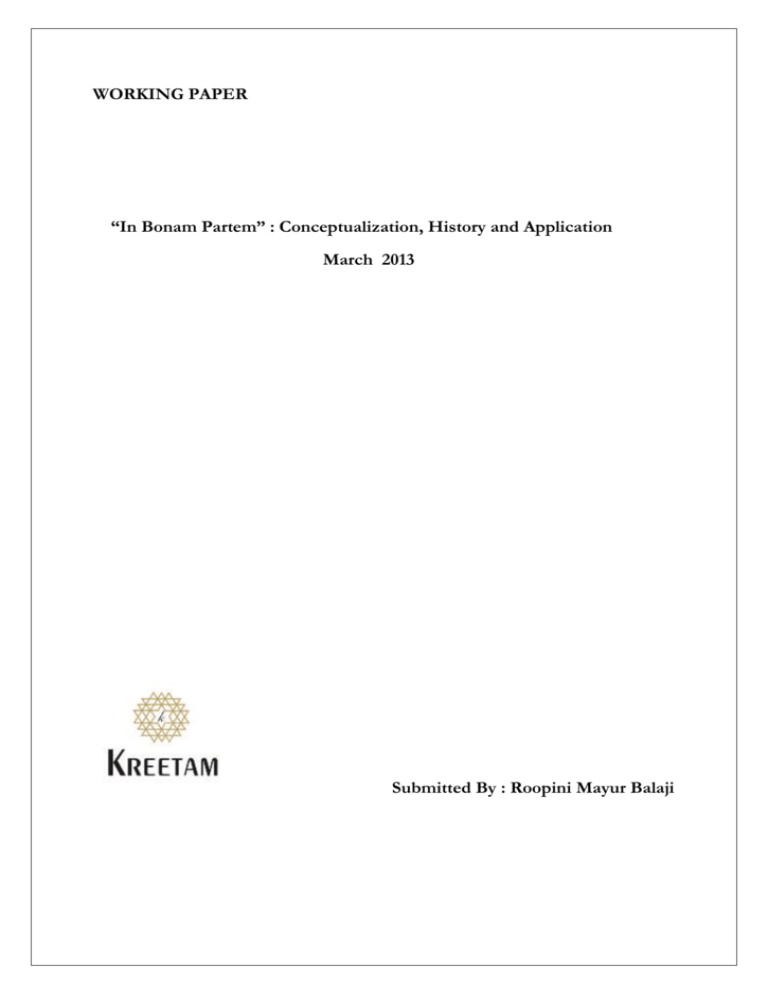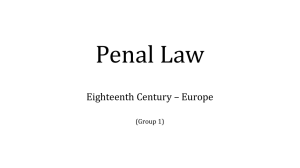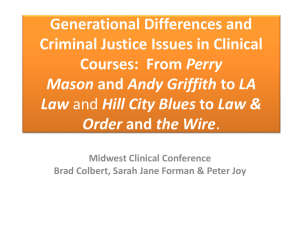“In Bonam Partem” : Conceptualization, History and
advertisement

WORKING PAPER “In Bonam Partem” : Conceptualization, History and Application March 2013 Submitted By : Roopini Mayur Balaji Disclaimer This article has been authored by _______and _____________ as a part of “Project White Paper”- an initiative by Kreetam and contains the views and opinions of the authors. The purpose of the paper is purely educational. Contents Introduction It introduces the reader to the principle of Bonam Partem and aims at providing a concise preamble to the discussion. Background in brevity It provides a brief history of the principle, and its evolution over the years. Application of interpretation of statutes It provides insight into the wide scope of the principle in various realms of law. Criminal law : A panorama It provides insight into the application of the rule in criminal jurisprudence. Criminal law and interpretation of statutes : It is a comparative study of applicability in A juxtaposition both fields of law. Conclusion It concludes the discussion. References It includes all documents/books referred. “Charity doth always interpret doubtful things favourably” - Robert Hooker INTRODUCTION The rule of ‘Bonam Partem’ today is a window to explore new panaceas. As though in compliance and conformity to the broadening of societal mindsets, the rule too keeps pace, and offers a plethora of new interpretations to oft-quoted dicta and oft-used provisions of a statute. The principle of ‘Bonam Partem’ is almost unnaturally closely related to the principle of ‘Mitiori Sensu’, which literally means the interpretation of words in their “Milder Sense”. Hence the term Bonam Partem is known to mean the interpretation of words in their least aggravated sense. Diametrically opposite to this are the premises of ‘Malam Partem’ and ‘Malo Sensu’, which are known to mean the acceptation of words in their most aggravated comprehension. In actions of slander, it was formerly the rule that, if the words alleged would admit of two constructions, then they must be taken in the less injurious and defamatory sense. The core premise of this principle is the acceptation of ambiguity as a grounds for the presumption of innocence. It is also in accordance with the judiciary’s traditional reluctance to label a statement as being defamatory or derogatory when it can have a plausible innocent intention. It gives effect to the adage – “Interpretationem in Bonam partem faciendum esse” which means that things must be interpreted in their better sense. Tracing the etymology of the term would bring us to the conclusion that ‘Bonam Partem’ would literally mean ‘The good side or part’, but that would only restrict the scope of a term that has a cosmopolitan application in today’s world. The Modus Operandi of the application of this principle has both a personal and a privileged flavour. A country’s judiciary is in a position of privilege to interpret its national statutory principles with the aid of this principle. Also, an attorney might find that this principle comes in handy while dealing with the proceedings of a lawsuit. Therefore, a visible pattern of the usage of this principle in defamation cases and in the interpretation of statutes is evidently seen. BACKGROUND IN BREVITY From the mid-sixteenth to the mid-seventeeth century, English defamation law operated with the hermeneutic rule of Bonam partem. The rule stipulated that if a statement can be construed both in a defamatory and an innocent sense, the latter must be considered as the true meaning. Further, as Coke explains, “Where the words are general or ambiguous, the more favourable reading must take precedence”. Thus, to take up a standard textbook case, to accuse someone of having the French pox (Syphilis) would be actionable,but since ‘pox’ taken alone, could refer either to French pox or Small pox, if a person was charged with defamation for having called someone a ‘poxy knave’, the court would dismiss the charge by interpreting ‘poxy’ in Bonam partem as a reference to Small pox, which was not an actionable insult. This rule, which seemed to date from the 14th century, became a standard principle, in continental defamation law as well as English. The rule of Bonam partem could, however, authorize what would seem to be the radically different strategy of creative hyper literalism. To rebut a defamation charge, the defendant usually found it sufficient to show that their words, even if strictly construed, would have an innocent sense, regardless of what the context indicated the speaker’s intention to have been. The most notorious (and oft-cited) example is of one Astgrigg’s allegation that ‘’Sir Thomas Holt struck his cook’s head with a cleaver, and cleaved it in half”. Holt sued in King’s Bench, but the jury decided for the defendant on the grounds that Astgrigg had not said that the cook died, and since he had not accused Holt of killing his cook, the words were not actionable. However implausible the verdict in this instance, it rested on legal principles of far-reaching importance. It was held that for the law to consider words as defamatory, two things were requisite : 1) That the person who is scandalized is certain 2) That the scandal is apparent from the words themselves Conversely, if the words did not refer unambiguously to specific persons, or did not explicitly allege an actionable offence, then they will be interpreted in Bonam partem. Even today, the principle of Bonam Partem is considered to be a hermeneutic that allows for wiggle room. It was therefore, not surprisingly, to a hermeneutic that poets and playwrights regularly appealed to defend their words against what Jonson calls “.....the sinister application Of the malicious, ignorant, and base Interpreter, who will distort and strain The general scope and purpose of an author, To his particular and private spleen.....” As expected, poets and playwrights got away with violations of nearly unbelievable magnitude. Yet, both in law and literature, the reading of Bonam Partem could have a distinct air of improbability, so one wonders why the courts sanctioned the same. Modern reviews of English law view the rule of Bonam partem as an attempt to curtail the rapid rise in civil defamation suits, since the rule allowed the judges to throw out any case in which the alleged words could be construed innocently. Yet, there could have been other numerous ways to reduce the number of civil defamation cases (like putting a ceiling on damages). This only showcases the apparent loopholes in the primal legal system. APPLICATION IN INTERPRETATION OF STATUTES CONSTRUCTION OF WORDS IN BONAM PARTEM : Interpretation of law depends on distinction between malice and good will, truth and deceit, words uttered in Bonam Partem and Malam Partem, but is wholly incapable of generating the rules of distinction between the same. Interpretation in words is decided by general or particular social context, by accompanying signs such as laughter or gestures, by the application of jurisprudential norms (like the prior presumption of innocence or guilt). The office of all judges is always to make such construction as shall suppress subtle inventions and evasions for the continuance of mischief, and to add cure and remedy, according to the true intent of the makers of the Act. Bennion, in ‘Statutory Interpretation’, states that construction in Bonam Partem is related to three specific legal principles : The first is that a person should never benefit from his own wrong. The second principle precludes from succeeding if he has to prove an unlawful act to claim the statutory benefit, and The third principle is that where a grant is in general terms, there is always an implied provision that it shall not include anything that is unlawful or immoral. It is said, and in a certain sense truly, that words must be taken in a lawful and rightful sense. When an Act, for instance, gives a certain efficacy to a fine levied on a land, it only means a fine lawfully levied. So, an Act which requires the payment of rates as a condition precedent to the exercise of a franchise, would not be construed as excluding from it a person who refused to pay a rate which was illegal, though so far valid that it had not been quashed or appealed against. Similarly, a covenant by a tenant to pay all parliamentary taxes, is construed to include such as he may lawfully pay, but not the landlord’s property tax, which it would be illegal for him to engage to pay. Where words of a statute have each a separate and distinct meaning, its exact sense, ought, prima facie, to be given to each. But the use of tautologies is not uncommon in statutes. Thus, an Act which makes it Felony ‘to falsely make, alter, forge, or counterfeit a bill of exchange’, gains little in strength or precision by using four words where one would have sufficed. It cannot be doubted that he who falsely makes, or alters, or counterfeits a bill, is guilty of forging it. In India, the interpretation of words in Bonam partem is to mean the interpretation of the words of a statute are to be interpreted in their rightful and lawful sense, with the provisions of Income Tax Act of 1961 being filled out as an exception. In order to prevent profiteers from escaping liability, illegal profits need to come under the purview of the Income Tax Act of 1961, and therefore, a visible non-applicability of the rule of Bonam partem is seen in this realm. A Queen’s Bench decision in the 19th century (1870 LR 5 QB 377), involved the interpretation of words in Bonam Partem. In this case the statute provided that "Where any witness shall answer every question relating to the matters aforesaid, " Commissioners appointed to inquire into corrupt election practices should issue him with a certificate which would entire him to certain immunities. The case turned on the meaning of the words, "shall answer every question ", "Does that mean, " asked Blackburn J (at pp 384,385), "If he shall give an answer in fact, thought it may be false to his knowledge; though it may be a matter of ridicule, and turning the whole commission and inquiry into contempt, can it be intended that if the witness gives an answer which is transparently false, he should get the immunity? It was held that it was not so intended. "Whenever the legislature in this Act requires a person to answer question the meaning is that he shall answer them truly, to the best of his knowledge and belief " Only then would he be entitled to the statutory certificate. The principle, that where an Act refers to a thing being done, it is to be taken as referring to the thing being lawfully done, has been applied in several recent cases, and hence revolves around the spirit of Bonam Partem. A similar Indian case which holds relevance here is Birla Group Holdings Ltd Vs. Assessee. This involved the words of the legislature (sic.) “tax payable on the basis of any returns”, in the Indian Income Tax Act of 1961. Construing the words in their least aggravated sense, i.e., in Bonam partem, it was deemed to have meant the tax payable on the basis of all legal returns and revenue, in the sense,disclosing correct income. Consequentially, the Income Tax eventually came to be excepted to the rule of Bonam partem, in lieu of money laundering. A CRIMINAL PANORAMA As with any other provisions, the application of criminal law includes an element of interpretation. The idea of the judge being the ‘silent mouth’ that pronounces the words of law is a myth abandoned long ago. The interpretation of criminal law involves one peculiarity derived from the principle of legality. Analogical interpretation is not allowed if it is in Malam Partem or against the defendant. However an interpretation in Bonam partem is sustained. This rule does not stem from the principle ‘Pro Reo”, the validity of which affects only the evaluation of evidence. Strictly speaking, its roots are in the principles of ‘Pro Libertate’ or ‘Favour Libertatis’ which affects the whole legal entire system subject to the rule of law. Similarly, an Amicus Curiae brief was submitted, to help decide the question of applicable terrorism offence in the proceedings before the Special Tribunal for Lebanon. It opined that, primarily, Lebanese law did not allow for internationalization of domestic criminal law. Even though that a concluding offence definition in Lebanese law did not need interpretative assistance by international law, it does not stand in the way of an interpretation in Bonam partem, i.e, an interpretation which would restrict the offence definition in favour of the accused. Indeed, the Lebanese law itself recognizes the retroactivity Bonam partem , in the sense of the French ‘retroactive in mitius’, explicitly. Thus, an amendment in Bonam partem would be admissible, also if brought about by international law. It was thus concluded that there exists no cogent rule in international law which would allow for a Bonam partem interpretation or restriction of the provisions of the Lebanese Criminal Code. The European Covenant On Human Rights (Art.7) does not entitle an accused person to the benefit of a change in the law which has occurred between the commission of the offence and the trial. However, while Art.7 prohibits the retrospective application of criminal law to an accused’s disadvantage, it does not prevent the retrospective application of the criminal law in Bonam partem. According to the Venice Commission (2007), the principle of retroaction of the more favourable criminal law does not only refer to the case in which the posterior criminal law provides that a certain act no longer constitutes a criminal offence or is punished with a less severe sentence; it also refers to any case in which the posterior law is in any manner more favourable to the accused, for example, where it better guarantees the legality principle and allows for a clearer and surer definition of the offence, notably of its constituent elements, thus reducing the overbroad discretionality or the possible arbitrariness of the public prosecution. However, this principle does not see an omni-European application, as the Armenian constitution not only prohibits the retroactive application of criminal law in Malam Partem, but also the retroactive application of criminal law in Bonam partem as well. An adequate interpretation of the legal principle of Bonam Partem offers sound analogy in criminal law, albeit in a limited way. Even when the state/judge excludes or limits the use of analogy, all norms must be implemented. Therefore, a good part of analogy must be seen as an exceptional mechanism in criminal law in the presence of axiomatic inconsistencies, that the Parliament did not foresee, and did not want. These exceptional law-making powers of a judge lend to the crime institution an argumentative framework. The principle of Bonam Partem is an instrument to create supra-legal justifications, and mitigating circumstances, but not to exclude other kinds of punishment institutions. CRIMINAL LAW AND INTERPRETATION OF STATUTES : A JUXTAPOSITION IN BONAM PARTEM While interpreting a statute in criminal law, a judge is not limited to grammatical interpretations alone, and may use all methods of interpretation required to recognise the true intent of the legislature, provided that he does not aim at the completion of law through the punishment of acts which the legislature has not included in the definitions of offence. When there are two equally reasonable interpretations of a penal statute, the narrower will certainly not be preferred, if the wider one is more compatible with the manifest intention of the legislature, as it emerges from the whole text of the relevant law. The narrower, restrictive interpretation is applicable only in cases where there is a real ambiguity in choosing between that and the wider one. This is supported both by legal theory and jurisprudence. In other words, the narrower interpretation which must be followed, according to prevailing medieval laws in respect of penal laws, means that a penal law cannot be interpreted as covering any cases which do not clearly fall within its provisional purview, and in the case of doubt, the benefit shall be given to the accused (in dubio pro mitiore). In relation to the application of restrictive interpretation to penal laws, it is useful to mention the view here according to which, in case of penal provisions,have become anachronistic due to later social and economic developments, a particularly strict application of such an application is necessary. In this respect, the following passage from the article of Livingston Hall titled “Strict or Liberal Constructions of Penal Statutes” (pp 767-768) are very pertinent : “The dead hand of the past, where it bars rather than leads social progress,must be narrowly limited in scope,until outright repeal becomes possible. This does not do violence to the legislature in its true sense. Although usually perpetual in form, statutes are passed in the light of the conditions of the time, and there would seem no proper ground for inferring that the legislators of one generation ever intended to insist upon a broad interpretation of their statutes, where they run clearly contrary to the social and economic policies of a subsequent generation”. On the other hand, it is accepted that the exclusion of the method of interpretation by analogy, on the basis of the rule under consideration is not applicable in Bonam Partem, i.e., in cases where the interpretation entails the discharge from the narrowing down on criminal responsibility and generally the restriction of adverse effects of penal laws. This is because of the general rule that provisions, which protect individual freedom, must be interpreted in the favour of the subject – in this context, the accused or the convict – and not against them. This is of course, applicable on condition that the application of the method of interpretation by analogy in a concrete case is not incompatible with the intention of the legislature. It should also be pointed out that the teleological interpretation, that is, the interpretation that aims at the implementation of a purpose of a certain legal provision, can only be used in the case of doubt and not in order to establish or increase criminal offences which are precluded by the wording of the law. CONCLUSION As far as penal law is concerned, it is not correct to say that ordinary language use restricts retribution to the realm of punishment and penance. Given the continuous shifts in meaning occurring in the use of language, this assessment may differ with regard to time and place. It also knows it in Bonam Partem. Furthermore, one can never make an appeal to naive experience to show that a particular concept should not be understood in a specific aspectual sense. Naive experience, for that matter, does not explicitly distinguish the aspects as is done in theoretical thought that abstracts from cosmic time. Non-theoretical experience, much rather, is fully embedded in concrete reality and therefore only implicitly understands the modal aspects as they are present in concrete things, events and societal relationships. This explains why everyday language-use acknowledges the anticipations from the natural sides of reality to the jural aspect. It must be evident that if retribution is to be considered as the nuclear meaning of the juridical aspect, it must be detached from the typical controversy in a special branch of jurisprudence. Retribution is not only exercised in Malam Partem, but also in Bonam Partem. As far its applicability in interpretation is concerned, it is a legal measure of proportionality that can be applied to every possible legal consequence, connected with any juristic force. But why do we see a trend towards interpreting statements in Bonam Partem, right from cases of defamation, to official statements of the legislature? It is a dogmatic presupposition that the courts tend towards reformative punishment, in lieu of human rights. William Wordsworth got it right when he said, in his archetypal melancholy undercurrent, “ Have I not reason to lament... What man has made of man?”. A last-ditch attempt at attaining Utopia, no doubt. The worldwide trend is to give humanity a chance, to offer the world a chance to righten itself. When the legal system gets caught in a landslide, it is bonefide concepts such as Bonam Partem that provide an anchor; Even then, the concept of Bonam Partem has an element of rationalism embedded in it. It is often assumed that a person benefitting from a ruling in favour of a Bonam Partem interpretation is like a person having the cake, eating it, and given half a chance, marrying the baker’s daughter too. But only when metaphors such as these are created, can we recognize a likeness between an economy and the law. Both have a shelf-life, and are expected to operate within that time before witnessing an invariable meltdown. But in times of crises, concepts such as the going concern of a company, and the Bonam Partem interpretation offer a life raft and help in bringing about a facelift in the economy and the law, respectively. So before we can say, World, Hold On, let’s hope the law catches up. REFERENCES : On the Interpretation Of Statutes – Peter Banson Maxwell Censorship and cultural Sensibility – Debora Shuger Opinion of the European Commission For Democracy Through Law , Strasbourg, 2009 Essays on the Developing Law of Human Rights – Loukes. G. Loukaides







